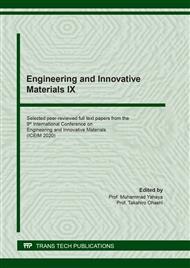p.3
p.9
p.17
p.23
p.29
p.35
p.43
p.49
Residual Stress Analysis in Deep Rolling Process on Gas Tungsten Arc Weld of Stainless Steel AISI 316L
Abstract:
Because of the general problem of the welding workpiece such as fatigue fracture caused by tensile residual stress lead to initial and propagation crack in the fusion zone. Thus, the mechanical surface treatment of deep rolling on Gas Tungsten Arc Welded (GTAW) surfaces of AISI 316L was studied. Deep rolling (DR) is a cold working process to induce compressive residual stress in the surface layer of the workpiece resulting in hardening deformation which increased surface hardness, and smooth surface that inhibit crack growth and improve fracture strength of materials. The present study focuses on compressive residual stress at the surface of stainless steel AISI 316L butt welded joint of GTAW. The three parameters of DR process were used; pressure 150 bar, rolling speed 400 mm/min, and step over 1.0 mm. The residual stresses analysis by X-ray diffraction with sin2Ψ method at 0, 5, 10, and 20 mm from the center of the welded bead. The results showed that the DR process on the welded of GTAW induce the minimum compressive residual stress-408.6 MPa and maximum-498.1 MPa in longitudinal direction. The results of transverse residual stress in minimum and maximum are 43.7 MPa and-34.8 MPa respectively. The FWHM of DR both longitudinal and transverse direction were increased in the same trend. Furthermore, the microhardness after DR treatment on workpiece surface layer higher than GTAW average 0.4 times.
Info:
Periodical:
Pages:
23-28
Citation:
Online since:
March 2021
Authors:
Price:
Сopyright:
© 2021 Trans Tech Publications Ltd. All Rights Reserved
Share:
Citation:


